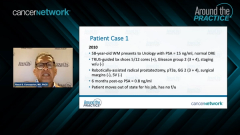
Case 2: 64-Year-Old Man With Multifocal Prostate Cancer Post-IMRT
Dr Raoul Concepcion leads a panel discussion on a case of a 64-year-old man with multifocal prostate cancer treated with IMRT who refused ADT.
Episodes in this series

Raoul S. Concepcion, MD, FACS: Let’s go to the second case, which is slightly different. We’re probably going to get into a discussion more to everybody’s point when we’re talking about a patient with much lower levels of PSA [prostate-specific antigen]. In this next case, in March 2016, a 64-year-old African American man presents to urology with a PSA of 5.8 ng/mL, and his DRE [digital rectal examination] is negative. The patient underwent multiparametric MRI of the prostate. He has a 66.3 volume gland and has a PI-RADS [prostate imaging reporting and data system] 4 lesion to the right peripheral zone measuring 1.5 cm. The patient undergoes mechanical fusion biopsy and 2 of 3 cores to the target area. Again, that is a PI-RADS 4 lesion, right peripheral zone, and he shows Gleason Group 3, 4+3, and then 3 of 12 systematic biopsies shows Gleason Group 4, 4+4, in the mid-left peripheral zone. He’s got a multifocal disease, not only in the right peripheral zone but also in the mid-left peripheral zone.
Staging work-up, bone scan and CT once again is negative. In this case, the patient opted for external beam radiation therapy, but he refused. As most of us know, patients with higher-risk prostate cancer should get 2 years of androgen deprivation therapy [ADT] along with their radiotherapy. However, the patient refused ADT because of the potential adverse-effect profile. He finishes his external beam therapy in 2016. These are the following PSAs dating from June 2017 and October 2017, and as you can see, he has this slow rise in PSA. For the first polling question, based on this PSA kinetics, would you restage the patient at this point? Yes or no? He finished radiotherapy in 2016. He had a PSA of 0.8 in June of 2017, and a PSA of 1.7 in June of 2018. On this PSA kinetics, would you restage the patient at this point? Yes or no? Looks like the polling is getting ready to conclude.
There is 1 question in the queue, which I’ll get to. According to the audience, basically 80%—the vast majority—say they would go ahead and restage as close to 90%. What imaging modality would you use to restage this patient? [The options are] technician bone scan and CT, whole-body MRI, Fluciclovine, gallium PSMA [prostate-specific membrane antigen], or C-11 choline, if you were going to restage? There is a question in the queue that somebody in the audience asked, just so we comment on this, the biochemical recurrence of 0.2 occurred 39 months after prostatectomy, and 6 years after prostatectomy the PSA is 0.62.
How can I balance the hope to get local treatment of oligometastatic tumors if found soon with the newest scans against the risk of more systemic metastases if I waited until all tumors can be seen? We’re probably going to answer this question with the role of imaging, so sit tight just for a second. The audience for this case—close to 60%—chose fluciclovine; 14% chose gallium PSMA, and 30% basically stuck with bone scan CT. I’m assuming that’s probably because of availability. Dr Moul, this is a patient whose PSA is low. He’s still below 2, but his doubling time looks to be under a year. How do you look at these patients? How do PSA values influence your choice of scans? Is it the value? Is it the doubling time? Is it the availability? How do you look at PSA relative? Does that impact your choice of scans?
Judd W. Moul, MD: This is an interesting case, as you said. Technically, this gentleman does not meet the ASTRO [American Society for Therapeutic Radiology and Oncology] Phoenix definition of recurrence because his PSA is still below. If I walked in the exam room and he was in poor health, and if I perceive that his life expectancy is going to be less than 10 years, I might reassure him and say “Sir, your PSA is still below 2, so you haven’t met the definition of recurrence. We’re just going to keep an eye on things, and I’ll follow you closely and see you again in 6 months.” On the other hand, his nadir was poor.
We know from data way back with Frank Crights back in your neck of the woods, Raoul. He used to say that even with radiation, if the PSA didn’t nadir at 0.2 or less, then it was ultimately going to be a failure. You could argue this in 2 ways. If he’s in poor health, I would probably observe him. If he was in robust health or I perceived he had a greater than 10-year life expectancy, I would work him up. An Axumin fluciclovine scan would be an ideal imaging test. That’s what we would use at Duke because that’s what we have. If I got pushback from the insurance companies, I might have to order the bone scan and CT first.
Transcript edited for clarity.
Newsletter
Stay up to date on recent advances in the multidisciplinary approach to cancer.

























































































